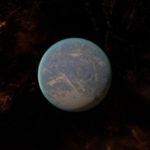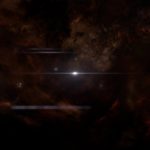System Specs:
- Stellar Mass: _ Sol-masses
- Stellar Class: _
- Luminosity: _ Sol
- Planets: 4
- Moons: 1
- Asteroid Belts: 0
- Asteroids: 0
- Objects: 3

The Scourge originated from this system. Civki‘s worlds are all affected one way or another as with many other systems in the Heleus Cluster.
Scourge Formation
DATA:
- Spatial anomaly related to the Scourge
- Dark energy discernible from gravitational and radiation effects
- Composition: Ice, mineral debris, element zero, unknown materials
ANALYSIS:
Energy emitted from this area appears weaker than expected. A probe deposited within the center of the formation may be used to collect data.
–
Planets Directory:
- H-065
- Rakaelmo
- H-309
- Khi Tasira
- H-110a
–
H-065:

- Orbital Distance: 1.4 AU
- Orbital Period: 1.3 Earth-years
- Keplerian Ratio: 1.624
- Radius: 5,678 km
- Day Length: 0.04 Earth-hours
- Atmospheric Pressure: 0.04 atm
- Surface Temp: 195 °C
- Surface Gravity: _ g
- Mass: _ Earth-masses
Although their surveys were inconclusive, Milky Way scientists believed H-065 was potentially inhabitable. Now it’s a scorching desert; whatever it was before the Scourge is lost.
Satellite
DATA:
- Satellite ID: Unknown
- Power readings: 98.2%
- System report: Scanners online
- Status: Operational
ANALYSIS:
This kett satellite is focused on H-065, taking detailed readings of seemingly empty expanses of desert.
–
Rakaelmo:

- Orbital Distance: 3.2 AU
- Orbital Period: 4.5 Earth-years
- Keplerian Ratio: 1.618
- Radius: 4,731 km
- Day Length: _ Earth-hours
- Atmospheric Pressure: 0.68 atm
- Surface Temp: 42 °C
- Surface Gravity: _ g
- Mass: _ Earth-masses
Massive storm systems wrack Rakaelmo. Dozens of kett shuttles skirt the edges of these storms, landing at Remnant ruins during brief moments of calm.
Iron
DATA:
Iron
ANALYSIS:
This large iron deposit can be rapidly mined and put to good use.
–
H-309:

- Orbital Distance: 4.5 AU
- Orbital Period: _ Earth-years
- Keplerian Ratio: 1.758
- Radius: 68,483 km
- Day Length: _ Earth-hours
- Atmospheric Pressure: 1.35 atm
- Surface Temp: _ °C
- Surface Gravity: _ g
- Mass: _ Earth-masses
Several kett vessels are present in H-309’s upper atmosphere, gathering helium-3 for fuel. The Scourge‘s disruption of the gas giant’s magnetosphere appears to be concealing us.
–
Khi Tasira:

DATA:
- Orbital distance: 4.9 AU
- Orbital period: 9.3 years
- Atmospheric pressure: 0.83 atmospheres
- Surface Temperature: 10 °C
ANALYSIS:
An enormous Remnant space station, which the Archon believes is Meridian.
ALERT: There is a strong kett presence in the area, and scans have picked up multiple kett warships orbiting the construct.
Roughly translated as “the place of ascension”, Khi Tasira is a city-sized Remnant structure in the Civki system. From our investigations, we now know the Archon‘s research over decades led him to believe this structure was Meridian, control center for the Remnant vault network.
This may explain why Khi Tasira is one of the most heavily defended Remnant sites in Heleus. A substantial percentage of the kett fleet is anchored here, while APEX reports the Archon has sent dozens of kett cryptologists and physicists there is an attempt to solve its mysteries, with a battalion of Exalted to defend them. Approaching Khi Tasira, therefore, is to breach one of the greatest kett strongholds in the Heleus Cluster.
Khi Tasira Explored
Even though Khi Tasira is not actually Meridian, but—as we now know—only a control module originally anchored into Meridian proper, the city remains a hugely significant Remnant site. It was home to a large population of the Remnant builders, the Jardaan, and still houses many of their experimental creations. The Remnant ships housed there appear to be in working order, as are most of the databanks and archives. Preserved despite the kett’s efforts to ransack it for information, with study, the city could eventually present a glimpse into the Jardaan’s motivations and a better understanding of the Remnant they left behind.
–
H-110a:

- Orbital Distance: 13.0 km
- Orbital Period: 36.2 Earth-days
- Keplerian Ratio: _
- Radius: _ 6,219 km
- Day Length: _ Earth-hours
- Atmospheric Pressure: 0.32 atm
- Surface Temp: -117 °C
- Surface Gravity: _ g
- Mass: _ Earth-masses
A satellite of the gas giant H-110, H-110a‘s orbit has begun to decay. The icy world may collide with the giant in as few as several centuries.
Ice Sheet
DATA:
- Surface area: 16 million km
- Composition: 94% ice water
- Status: Stable
ANALYSIS:
Beneath ten meters of solid ice is what appears to be a minor Remnant installation, as yet undiscovered by the kett.
–







